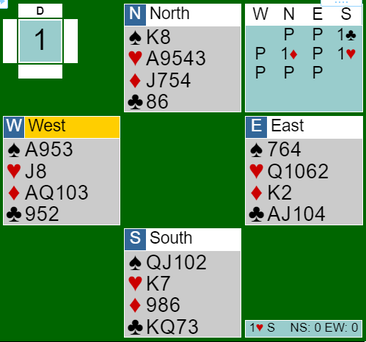AuthorSweden had a superb performance in the 2018 World Youth Teams Championships, winning the Under-26 and Under-21 categories. In the U-26 (also known as the Juniors), the finals were played against Singapore, a country which has been steadily placing higher at World Championships in the past years. Those who follow Junior bridge know that, at the highest levels, the game is extremely aggressive and well played, and that the partnerships employ very sophisticated methods with great competence. When the finals of the 2018 World Championship began, the first board was an example of all that. These were the cards – being Board 1, this was all white, and North was the dealer: It is not unimaginable that a board like this would be passed out in many games, but that would not happen in present company. When the Swedes held the North-South cards, they were able to stop low by means of a transfer response, as seen in the diagram. 1 Diamond showed 4+ hearts, and 1 Heart showed a weak balanced hand. North was pleased to stop in 1 Heart.
Should EW have tried harder to push the Swedes around? Then again, they can’t even make 1NT, so that is not without its risks. In any case, N-S cannot make 7 tricks, right? They are slated to lose 1 spade, 2 hearts, 3 diamonds and 1 club. But this is without taking into account the advantage of transferring the play of the hand to South. West started with a difficult lead, and picked the 5 of spades. Ida Grönkvist played the King from dummy, as East discouraged with the 7. Declarer played a second spade. East did his best to encourage a diamond switch by playing the 6 of spades in that trick, but it was not enough; West played a third spade, and declarer seized the opportunity to discard two diamonds from the table, as East ruffed with a natural trump trick. That was that. Perhaps West should heed the old saying that both sides should not be attacking the same suit, but we must credit the transfer response with some part of this result. This was already a good result for Sweden, but it became even better when Zhou for Singapore, at the other table, decided to open the North cards with an anemic 2 Hearts. This could have worked out better, of course, as is often the case with preempts, but I suspect that this decision was not purely technical; at the start of a very long match, it is tactically wise to plant some doubts upon your opponents’ minds regarding your style of preempts. In any case, if it worked out fine, it would give the Singaporeans a psychological edge. As it happened, though, it backfired when West reopened with a double and East decided to pass rather than to look for a game. (This decision, facing an unpassed partner, was also probably influenced by psychological and tactical considerations – grabbing a penalty at the first board is never unwelcome). The sum of both decisions was a great board for Sweden, compounded by the fact that when dummy was South, West had little difficulty in switching to a small diamond after winning the Ace of spades. (A spade was also led here, by East). The Swedes defended carefully to extract the maximum penalty: spade lead ducked, then West won the continuation and played a small diamond; East won the King, cashed the Ace of clubs, and returned a diamond. As West cashed his diamonds, East pitched the last spade. A spade was played for a ruff, and a further trump trick was lost later. 300 and 80 for Sweden amounted to a good start, 9 IMPs.
0 Comments
|
Archives
September 2021
Categories
All
|

 RSS Feed
RSS Feed